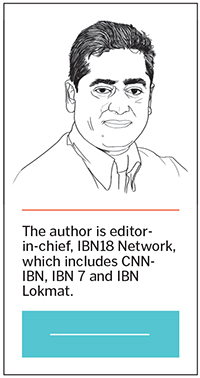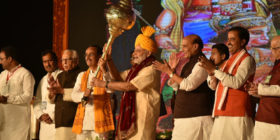The chemistry and momentum is clearly with a charismatic Modi but will he have the numbers to become India’s next prime minister?
For almost three decades, Sharad Pawar has been India’s prime minister-in-waiting. A few years ago, when journalists asked him if he had finally given up on his prime ministerial ambitions, the Maharashtra leader candidly admitted that with a party of less than 10 MPs, his chances for the top job were virtually nil. But then, he cheekily added, “If Deve Gowda can do it, I guess anyone can aspire to be prime minister!”
Kaun Banega Pradhan Mantri promises to be India’s longest running political serial in 2014. Where once the question asked to political pundits was ‘who will form the next government’, now the question raised is ‘who will be the next prime minister’. That, perhaps, is the ‘Narendra Modi effect’ on Indian politics. A party-based political system is now being pushed towards becoming a presidential system where the Indian voter is being asked to choose which individual is best suited to reside at 7 Race Course Road.

Modi has been the most open and direct in expressing his desire to become India’s next prime minister. His “Mission 272” is being run with a war room-like aggression designed to propel the Gujarat chief minister from Gandhinagar to Delhi. It is clear that Modi, through a mix of artful image building and personal endeavour, has been able to strike a chord as a tough, decisive leader committed to good governance. He has been helped in no small measure by Dr Manmohan Singh and Rahul Gandhi. Their perceived weakness makes Modi stand out as a 21st century Iron Man who will deliver the country from sloth and inefficiency. For a younger, aspirational India, Modi’s brand of sharp-edged politics is contrasted with Rahul’s NGO-like approach to public life. Forget the 2002 riots and Modi’s questionable record on Hindu-Muslim relations: Younger India wants to shake off the burdens of the past and appears to be hankering for a ‘man on a white horse’ who will offer instant solutions for the future.
The chemistry then is clearly with a charismatic Modi. But Indian elections are as much about arithmetic as they are about chemistry. The first big question then to answer in 2014 is this: Will Modi have the numbers to be in pole position to become India’s next prime minister? Truth is, Mission 272 is really Mission 220. There are about ten states spread between Maharashtra in the west through to Bihar in the north that will decide Modi’s political future. The nearly 300 seats on offer in these states are the fertile ground where Modi must reap a rich harvest if he is to have a realistic chance of fulfilling his ambition.
In that context, the 2013 winter elections do offer some pointers. While the stunning debut of Arvind Kejriwal and the AAP party has dominated the headlines, the real story of these elections was in Rajasthan. By winning an astounding 162 seats out of 200 with a vote share swing of 11 percent, the BJP has benefited from a tidal wave in its favour. This cannot be explained as normal ‘anti-incumbency’, but does suggest that the Modi factor gave the BJP an incremental vote that propelled the party to a four-fifths thumping win. Was Rajasthan an exception, or is it a harbinger of what can be best described as a north-west monsoon that may sweep across India in 2014, driving Team Modi towards the promised land?
Illustration: Sameer Pawar
Remember a potential north-west monsoon in favour of the BJP may be countered by a south-east drought that continues to stare the saffron combine across a vast geographical area accounting for over 250 seats. The key to power then lies in two states—Bihar and Uttar Pradesh—and in the ability of the BJP to strike post-poll alliances. Of the 120 seats on offer in the two big states of the Hindi heartland, the BJP must win at least 70 seats. Of potential allies, the BJP may need at least two, if not three, of Jayalalithaa, Mamata Banerjee, Mayawati and Jagan Reddy to align with them.
As the BJP does its number crunching with an eye on government formation, the Congress faces a different challenge: How to ensure that the party doesn’t dip below the three-figure mark and how to protect its heir-apparent from the potentially damaging consequences of a bad defeat. A litany of scams and an economic slowdown have meant that the perception war has already been lost. Now, it just wants to protect its self-esteem as a national party. Rahul Gandhi’s own politics appear to be looking beyond 2014, even a possible period in the opposition, if only to rid the party of an old guard which has resisted any attempt at overturning the status quo.
Two-thousand-fourteen then is not an election that the Congress is fighting to win, but to prevent the other side from crossing the line. It’s a bit like the Indian cricket teams of the ’50s and ’60s which looked for an honourable draw rather than pushing for a victory. For the Congress, 2014 is now about ‘anyone but Modi’: It is almost a clarion call for a revival of a potential 1996-like third front experiment, or even a BJP-led government that has as its prime minister someone other than the BJP’s ‘Chosen One’.
Which is also why the Congress leadership has been looking at Kejriwal’s success with hope and amazement: If a political startup can set the agenda in the national capital, why is a 128-year-old party of the freedom movement unable to shake itself from its self-inflicted stupor? Kejriwal may well be a Delhi phenomenon for now, but his style of mass politics has offered a potential alternative to the two-party system. Kejriwal-led urban politics, aided by an increasingly assertive middle class and a vocal media, offers some relief to those who are desperate for change.
And if change is indeed in the air, then here’s the sign of it: In the CNN IBN-CSDS pre poll survey of Delhi, nearly half of those who said they would vote for Kejriwal in a state election, said they would vote for Modi in a general election. This urge for change may well be disruptive but it is, at the moment, the driving force of Indian politics. Like him or hate him, the ‘Big Mo’ (momentum) is with the man from Vadnagar. But he, like all other potential prime ministers, must beware of the unknown Deve Gowda-like figures waiting in the wings!






Leave a reply